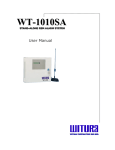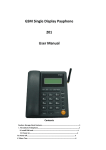Download User Manual
Transcript
GT-100 GSM Terminal use as back up alarm panel User Manual GT-100 USER MANUAL Sketch of the GT-100 NETWORK INDICATOR (LED) The indicator is illuminated when the terminal is connected to GSM Network POWER INDICATOR (RED) The indicator is illuminated when mains power is present ANTENNA The antenna must be well connected before turn on the terminal Installation & Connections OUTPUT Connect the RS232 DB9 female cable to the terminal for controlling outputs and inputs ANTENNA PORT Connect the provided antenna to the Terminal SIM CARD The card holder is of "Push-Push" type PSTN PORT 2 Connect to PSTN Line POWER PORT Connect a 12V Power Supply to the Terminal GSM PORT 1 (ALARM INPUT) Connect to Alarm Panel / also function as Phone Input ON/OFF SWITCH Turn On or Off the Terminal GT-100 USER MANUAL Wiring Diagram B (DB9 Female Cable) Please check the following packing list: Name GT-100 Main Unit Telephone line DB9 Power adapter 3m GSM terminal antenna CD User’s Manual Quantity 1 1 1 1 1 Unit Set Set Set Set Set 1 Set GT-100 USER MANUAL Contents 1. Introduction to GT-100 GSM Terminal…………………………………………………………………………………………6 2. Main Features of the GT-100……………………….………………………………………………………………………………8 3. Installation Instruction…………………………………………………………………………………………………………………9 3.1 Description…………………………………………………………………………………………………………………………….9 3.2 GT-100 Inputs & Outputs Wiring Instructions………….……………………………………………………….10 3.3 Installing the SIM Card………………………………………………………………………………………………………11 3.4 Meaning of LEDs GT-100……………………………………………………………………….…………………………..12 4. GT-100 Configuration Instructions (Via Voice)………….………………….…………………………………………13 4.1 Introduction…………………………………………………………………………………………………………………….…13 Step1- Enter Programming Mode…………………………………………………………………………………………………14 1. Reset the GT-100 Unit………………………………………………………………………………………………………………14 2. Changing GT-100 Password………………………………………………………………………………………………………14 3. Programming the Administrator/CMS Number……………………………….……………………………………….14 4. Delete administrator …….………………………………………………………………………………………………….………14 5. Setting the Recipient that will receive Alert Messages…………………………………………………………..15 6. Setting the Recipient that will not receive Alert Messages………………………………………………………15 7. Programming the Area Code……………………………………………………………………………………………………..15 8. Programming to delete Area Code…………………………………………………………………………………………….15 9. Setting the dialing Speed Number……………………………………………………………………………………………15 10. Clock Setting……………………………………………………………………………………………………………………………15 11. Setting the Account Number for CMS ……………………………………………………………………………………16 12. Setting the Auto Test Report Time Section 1…………………………………………………………………………16 13. Setting the Auto Test Report Time Section 2………………………………………………………………………..16 14. Setting the Auto Test Report Time Section 3………………………………………………………………………..16 15. Enable the function of Reports to CMS………………………………………………………………………………….16 16. Disable the function of Reports to CMS…………………………………………………………………………………16 17. Enable the generation of sms report for auto test……………………………………………………………….16 18. Disable the generation of sms report for auto test……………………………………………………………….16 19. Setting the Burst On and Burst Off time of DTMF tones for CMS reporting…………………………17 20. Setting for PSTN send sms Failure…………………………………………………………………………………………17 21. Setting for PSTN sending report to CMS (Failure)…………………………………………………………………17 22. Setting for PSTN send to CMS when the PSTN connected…………………………………………………….17 23. Setting for AC Failure………………………………………………………………………………………………………………18 24. Input Settings………………………………………………………………………………………………………………………….18 25. Enable/Disable System Power Up SMS Notification………………………………………………………………18 26. Ignore the front dialing digits when dialing the Administrator or CMS number via Voice…..19 27. Adjusting the Speaker and Microphone Volume level via Voice…………………………………………..19 5. GT-100 Programming Instructions (Via SMS)………………………………………………………………………….20 5.1 GT-100 Use password to Programming the Administrator/CMS Number. (Via SMS)…………..20 5.2 GT-100 Programming the Administrator/CMS Number. (Via SMS)……………………………………….21 5.3 Setting the Recipient that will Received Alert Messages via SMS………………………………………….22 5.4 Programmed the Account Number for Event Reporting to CMS via sms………………………………23 5.5 Programmed time via SMS …………………………………………………………………………………………………….24 GT-100 USER MANUAL 5.6 Programmed the Auto Test Report Time Section 1, 2, 3 report via SMS……………………………..24 5.7 Auto test enable and disable the function of Reports to CMS via SMS ………………………………..25 5.8 Auto test enable and disable the function of Reports SMS to admin number via SMS………..25 5.9 Programming the Area Code via SMS …………………………………………………………………………………….26 6. Adjusting the Speaker and Microphone Volume level via SMS………………………………………………..27 6.1 Enable and disable for PSTN send SMS reports when failed or connected……………………………27 6.2 Enable and disable for reports PSTN failed or connected to CMS…………………………………………28 6.3 Enable and disable for reports AC power failed or connected to sending SMS……………………28 6.4 Enable and disable for sending reports to CMS when AC power failed or connected………….29 6.5 Input Settings 5~12 volt high Pulse Stands for generation of SMS…………………………………….30 6.6 Input Settings 0 volt low Pulse stands for generation of SMS……………………………………………..30 6.7 Stands for send report to CMC when input triggered high pulse or low pulse…………………….31 6.8 (Power up) stand for generation of SMS when GT-100 is turned On…………………………………..31 6.9 Activate the output relay number when input triggered………………………………………………………32 7. Editing the Inputs Alert Messages (detecting 5~12VDC triggered)……………………….………………32 7.1 Editing the Input Alert Message For (detecting 0 VDC triggered)………………………………………..33 7.2 Editing the Outputs (Open) Alert Messages…………………………………………………………………………..33 7.3 Editing the Outputs (Closed) Alert Messages…………………………………………………………………….….34 7.4 Activate Output to Stay On for a Specific Time…………………………………………………………………….35 7.5 Activate the Output Relay to Stay On……………………………………………………………………………………36 7.6 Setup User List to trip the output 1, 2, 3 via SMS………………………………………………………………..37 7.7 Check User List Number by individually via SMS………………………………………………………………….38 7.8 Erase User List Number via SMS…………………………………………………………………………………………….38 7.9 Output Pulse time via SMS…………………………………………………………………………………………………….39 8. Use password to control the output stay On via SMS……………………………………………………………..40 8.1 Use password to control the output stay Specific Time………………………………………………………….41 8.2 Reset the GT-100 unit via SMS…………………………………………………………………………….…………………41 8.3 Changing the Programming Mode Password via SMS…………….………………………………………………42 8.4 Checking the Signal Strength via SMS……………………………………………………………………………………42 8.5 Inquire the Software and Hardware Version GT-100 Terminal via SMS……………………………….43 8.6 Inquire All Programmed Administrator via SMS………………………………………………………………………43 8.7 Inquire the All Status……………………………………………………………………………………………………………….44 8.8 Checking the Current Time Status via SMS…………………………………………………………………………….44 9. Technical Specifications……………………………………………………………………………………………………………..45 GT-100 USER MANUAL 1. Introduction to the GT-100 GSM Alarm System The GT-100 GSM Terminal is a wireless communicator for alarm and fire panels that uses the cell phone network (GSM) to transmit alarms and other panel event. The module checks the status of the PSTN line and in case the PSTN line becomes unavailable, the GT-100 GSM emulate the line signal to the panel. At this time, the panel will dial out using the GSM cell phone network to communicate with the receiver at the monitoring station and transmit the alarms.GT-100 offer a number of solutions to open gates by a simple phone call. Just dial a number to open your gates. GT-100 User List of numbers who are enabled to open the phone, up to 100. GENERAL OVERVIEW: GT-100 USER MANUAL GT-100 USER MANUAL 2. Main Features of the GT-100 1. Panel compatibility - Allows any contact ID alarm panel to transmit alarms over GSM using the GSM voice channel 2. Telephone line backup:GT-100 give priority to the lowest cost network. GT-100 uses the telephone line as the main transmission line and uses the GSM voice channel as backup 3. GT-100 offers a number of solutions to open gates by a simple phone call. Just dial a number to open your gates. GT-100 User List of numbers who are enabled to open the phone, up to 100. 4. Programmable CMS Account Number: The GT-100 has built-in alarm inputs that allow the unit to send additional signals (with user programmable Account number) to the CMS monitoring station. The Alarm Events that available in this system are Input, PSTN Failure, AC Failure and Auto Test. Supported Protocol: ( Ademco Contact ID) 5. Sends text messages to user programmable cell phone number (SMS): The GT-100 can be programmed to send a SMS to a programmable cell phone number to notify the user that the PSTN line has been cut off or unavailable. 6. Three digital inputs: The system has the function to send SMS and call to the user in the event of input triggered. For example, Input 3 connected to an electric door, when there is intruder or the electric door is open illegally, GT-100 will receive short circuit impulse on Input 3 and automatically sends a signal to the pre-set number and notify the owner or send reporting to CMS (Ademco Contact ID) 7. Three remote control outputs: These open collector outputs (that can sink max 300ma per output) can be turned on and off remotely through a SMS or phone call. Remote control will be reachable by sending a SMS or phone call with a certain command. For example SMS/Call in to switch on lighting, air conditional, generator, sensor or other equipment. 8. Standby rechargeable battery to prevent power failure or electricity cut off by intruder. The GSM will function as normal when no electricity supply. LED to check the GSM signal strength. 9. Low power consumption - uses 30mA while in idle state and 260mA when transmitting an alarm GT-100 USER MANUAL 3. Installation Instructions Note: It is essential that you read the step by step instructions fully prior to installing and programming the unit 3.1) Description 1. Antenna: connect the antenna to the GSM module; place the antenna as far as possible from the GT-100 and do not leave any coiling of the antenna cable to avoid radiant interference 2. SIM Card: disable the PIN code and set it to 1234 (default) For Transmitter Mode (Data or SMS): as with any transmitter, it requires an identifier, receiver telephone numbers, etc (refer to the complete information on Programming page) 3. Line Input: connect the line input to the PSTN or ISDN network. 4. Outputs (Back-Up Mode): connect the RS232 DB15 to additional remote controlling outputs. 5. Alarm Input: connect the input to output of the Alarm Panel / Control Panel. 6. Power Supply: connect to a 12V power supply 7. Operating State: Approximately 20s after power up check the operating state indicated by the Power SIM LED: the LED is steady during power up phase, and then blinks when the connection to the GSM network is established. The Signal indicator LED will stay lit whenever there is signal. GT-100 USER MANUAL 3.2) GT-100 Inputs and Outputs Wiring Instructions RLY1 (OUT1), RLY2 (OUT2), RLY3 (OUT3) Remote Controlling Outputs These open collector outputs can be turned on and off remotely through a SMS. Remote control will be reachable by sending a SMS with a certain command. Note: When sending normal SMS with command below, the GT-100 will turn On / Off the output relay and reply a message of output has turned On / Off to a programmable phone numbers. INPUT1, INPUT2, INPUT3 Connect INPUT1, INPUT2 and INPUT3 to inputs panel, when there is a short-circuit impulse on (INPUT1, INPUT2, INPUT3), the GT-100 is possible to send SMS to a programmable phone numbers. Inputs and Outputs Wiring Diagram GT-100 USER MANUAL 3.3) SIM Card Installation Note: Make sure that the GT-100 GSM terminal is not locked with a particular GSM network. This means that a user may use SIM card of any GSM service provider with a possibility to send SMS and to call. In order to control the module via a short call, SIM card should be have Caller ID option. Usually SIM cards have such option. If your card can not identify a caller, please contact GSM service provides or use another SIM card. Locate SIM card into a holder. Card's circuitry should look downward and card's key (cut angle) should look upwards. The card holder is of "Push-Push" type. This means that after pushing the card once, it is fixed and after pushing it again - it is released. Locate SIM card into a holder. Note: do not locate SIM card with force, because you may damage SIM card holder. GT-100 USER MANUAL 3.4) Meaning of LEDs GT-100 Name BUS(blue) Indication Variations Flashes Power supply ok and the GT-100 is registered to GSM network. Lights continuously GT-100 power supply is ok, but the GT100 failed to register to the GSM network. GT-100 power supply failure or it is switched off Off SIMCard(red) Network(white ) Meaning Lights continuously GT-100 has been registered to the network. Flashes, remains lit for 50ms, turn off for 300ms. GT-100 is being registered to the GSM network. Off GT-100 failed to register to the network. Lights continuously The GT-100 is functioning. Off The GT-100 is out of order or Failed. GT-100 USER MANUAL 4. GT-100 Programming Instructions (Via Fixed Line Phone) 4.1 Introduction The GT-100 can be programmed manually by a connected normal telephone. Note: Before commencing programming it is advisable to read the below programming setting instructions thoroughly. To start with programming, user must plug-in a normal single line phone to GSM. GT-100 USER MANUAL Step 1. Description for setting Entering the setting “**99999*” from a DTMF Phone in order to go into the Setting Mode. When hang-up the phone, it will save and quit from the setting mode. Pick up the Handset or press hands free, press **99999* to enter programming mode. If the password has entered correctly, you should If the setting is successful, there is a du~………….” sound. If the setting is wrong, there is a “~du~du~du~… ~” sound Now you may proceed with programming settings. 1. Reset the GT-100. To reset the unit, you can continue pressing *88*1# If the setting is successful, there is a “du~……..…” sound. 2. Changing GT-100 Password Continue pressing *99*xxxxx# If the setting is successful, there is a “du~……..…” sound. 3. Programming the Administrator/CMS Number. Administrator number 1 you should Continue pressing *1*xxxxxxxxxxxxxxxxx# If the setting is successful, there is a “du~……….…” sound. You may continue to program administrator number 2, 3, 4, and 5 by pressing *02* xxxxxxxxxxxxxxxxx# , *3* xxxxxxxxxxxxxxxxx# , *4* xxxxxxxxxxxxxxxxx# , *5* xxxxxxxxxxxxxxxxx# 4. To Delete administrator 1. Continue pressing *1*# If the setting is successful, there is a “du~……..…” sound. You may continue to program administrator number 2, 3, 4, and 5 by pressing *2*# , *3*# , *4*# , *5*# . Note: It is possible to program up to 20 digits for a telephone number 5. Setting the Recipient that will receive Alert Messages GT-100 USER MANUAL The unit can send text alerts to 1 or all 5 administrator of the programmed administrator 1 numbers to not receive alert messages. You may continue to program administrator number 2, 3, 4, and 5 by pressing *6*01111#. 2 admin 3 admin 4 admin 5 admin 6. Setting the Recipient that will not receive Alert Messages The unit can off send text alerts to 1 or all 5 of the programmed administrator 1 numbers to receive alert messages You may continue to program administrator number 2, 3, 4, and 5 by pressing *6*10000#. 2 admin 3 admin 4 admin 5 admin 7. Programming the Area Code Continue pressing *15*xxxxx# If the setting is successful, there is a “du~……….…” sound. 8. Programming to delete Area Code Continue pressing *15*# If the setting is successful, there is a “du~……………” sound. 9. Setting the dialing Speed to dialing out To set the required dialing on 3 seconds Continue pressing *16*03# If the setting is successful, there is a “du~…………” sound. 10. Clock Setting To set the time at 14.00.00 continue pressing *9*140000# If the setting is successful, there is a “du~……………” sound. Noted: The clock setting number must entered in 6 digits GT-100 USER MANUAL 11. Setting the Account Number for CMS To set the account number as 9999 continue pressing *8*9999# If the setting is successful, there is a “du~………..…” sound. Delete CMS account number *8*# If the setting is successful, there is a “du~……..…” sound. 12. Setting the Auto Test Report Time Section 1 To set the auto test report time at 12.00.00 continue pressing *10*120000# If the setting is successful, there is a “du~………..…” sound. 13. Setting the Auto Test Report Time Section 2 To set the auto test report time at 13.00.00 continue pressing *11*130000# If the setting is successful, there is a “du~…….…” sound. 14. Setting the Auto Test Report Time Section 3 To set the auto test report time at 14.00.00 continue pressing *12*140000# If the setting is successful, there is a “du~…………...…” sound. 15. Auto test Enable the function of Reports to CMS Continue pressing *13*1# If the setting is successful, there is a “du~……………….” sound. 16. Auto test Disable the function of Reports to CMS Continue pressing *13*0# If the setting is successful, there is a “du~……………..…” sound. 17. Enable the generation of sms report for auto test Continue pressing *14*1# If the setting is successful, there is a “du~……..…” sound. 18. Disable the generation of sms report for auto test Continue pressing *14*0# If the setting is successful, there is a “du…………~…” sound. GT-100 USER MANUAL 19. Setting the Burst On and Burst Off time of DTMF tones for CMS reporting Description: Value: 1 stands for 10~20ms continue pressing *31*11# If the setting is successful, there is a “du~……...…” sound. Value: 2 stands for 20~40ms continue pressing *31*22# If the setting is successful, there is a “du~………..…” sound. Value: 3 stands for 50~60ms continue pressing *31*33# If the setting is successful, there is a “du~………….…” sound. Value: 4 stands for 60~80ms continue pressing *31*44# If the setting is successful, there is a “du~……..……” sound. Value: 5 stands for 80~100ms continue pressing *31*55# If the setting is successful, there is a “du~……………” sound. 20. Setting for PSTN send sms Failure Turn on when PSTN Failure generation SMS continue pressing *19*1# If the setting is successful, there is a “du~……….…” sound. Disable send SMS when PSTN Failure continue pressing *19*0# If the setting is successful, there is a “du~………..…” sound. 21. Setting for PSTN sending report to CMS (Failure) Turn on when PSTN Failed generation sending report to CMS continue pressing *20*1# If the setting is successful, there is a “du~……………” sound. Disable sending report when PSTN Failure continue pressing *20*0# If the setting is successful, there is a “du~………..…” sound. 22. Setting for PSTN send to CMS when the PSTN connected Turn on send report to CMS when the PSTN connected continue pressing *21*1# If the setting is successful, there is a “du~………..…” sound. Disable sending report to CMS when the PSTN connected continue pressing *21*0# If the setting is successful, there is a “du~………….…” sound. GT-100 USER MANUAL 23. Setting for AC Failure Stands for generation of SMS when AC failed continue pressing *22*1# If the setting is successful, there is a “du~……….…” sound. Disable send SMS when AC failed continue pressing *22*0# If the setting is successful, there is a “du~……………” sound. Stands for send to CMS when AC failed continue pressing *23*1# If the setting is successful, there is a “du~………..…” sound. Disable send to CMS when AC failed continue pressing *23*0# If the setting is successful, there is a “du~……………” sound. Stands for send to CMS when AC connected continue pressing *24*1# If the setting is successful, there is a “du~……………” sound. Disable send to CMS when AC connected continue pressing *24*0# If the setting is successful, there is a “du~……………” sound. 24. Input Settings Stands for generation of SMS when input triggered (0 Volt low Pulse) (OFF) continue pressing *25*1# If the setting is successful, there is a “du~……….…” sound. Disable send SMS when input triggered (0 Volt low Pulse) (OFF) continue pressing *25*0# If the setting is successful, there is a “du~………..…” sound. Stands for generation of SMS when input triggered (5~12 volt high Pulse) (ON) continue pressing *26*1# If the setting is successful, there is a “du~……….…” sound. Disable send SMS when input triggered (5~12 volt Pulse) (ON) continue pressing *26*0# If the setting is successful, there is a “du~……….…” sound. Stands for send report to CMC when input triggered continue pressing *27*1# If the setting is successful, there is a “du~……….…” sound. Disable send to CMS when input triggered continue pressing *27*0# If the setting is successful, there is a “du~……..…” sound. 25. Enable/Disable System Power Up SMS Notification Enable the Power up SMS notification continue pressing *32*1# If the setting is successful, there is a “du~……….…” sound. Disable the power up SMS notification continue pressing *32*0# If the setting is successful, there is a “du~……..…” sound. GT-100 USER MANUAL 26. Ignore the front dialing digits when dialing the Administrator or CMS number via Voice To set the unit to ignore first 2 dialing digits you can continue pressing *18*2# If the setting is successful, there is a “du~……...…” sound. Disable the Ignore the front dialing digits continue pressing *18*0# If the setting is successful, there is a “du~…………” sound. 27. Adjusting the Speaker and Microphone Volume level via Voice (max 4 Level) To adjust the speaker volume to 4 and microphone volume to 4 you can continue press *17*44# If the setting is successful, there is a “du~du~du~…” sound GT-100 USER MANUAL 5. GT-100 Programming Instructions (Via SMS) The Administrator number must be programmed into the GT-100 unit first via phone mode or via SMS by password. Programming the GT-100 can also be done via SMS commands using your phone. Any programming command sent by SMS must be in CAPITAL letters. The fields between square brackets are parameters; do NOT enter the square brackets. When you send a command, you will receive the answer for the first time even if your GSM number is not in the administrator list. This happens because the GT-100 recognizes any GSM number as administrator and answers to it. 5.1 GT-100 Use password to Programming the Administrator/CMS Number. (Via SMS) The 5 administrator numbers can be programmed with a text command via SMS. Text Command: *PSS*[PPPPP]*ADM[N]#XXXXXXXXXX PPPPP stands for Password N stands for administrator number XXXXXXXXXX stands for the phone number you want to program as Administrator. Please note that it is possible to program up to a maximum of 16 digits for a phone number. Example: To program phone number 99938388383 as administrator into list number 1, you would send the following SMS command to the unit. *PSS*99999*ADM1#99938388383 Return Message admin1=99938388383 GT-100 USER MANUAL 5.2 GT-100 Programming the Administrator/CMS Number. (Via SMS) Note: It is advised that the owner should set the system to allow programming access for administrators only after programming the Administrator numbers via SMS program by password. The 5 administrator numbers can be programmed with a text command via SMS. Text Command: *ADM[N]*XXXXXXXXXX N stands for administrator number XXXXXXXXXX stands for the phone number you want to program as Administrator. Please note that it is possible to program up to a maximum of 16 digits for a phone number. Example: To program phone number 99938388383 as administrator into list number 1, you would send the following SMS command to the unit. *ADM1*99938388383 Return Message admin1=99938388383 To delete the administrator number *ADM2*# Return Message admin2-delete GT-100 USER MANUAL 5.3 Setting the Recipient that will Received Alert Messages via SMS The unit can send text alerts to 1 or all 5 of the programmed administrator’s numbers, via SMS Text Command: *SMAL*[NNNNN] 1 Admin 2 Admin 3 Admin 4 Admin 5 Admin N stands for administrator ON (1) or OFF (0) value Example: If you want the receive alert message to administrator 1 and 2 you would send the following SMS message to the unit. *SMAL*11000 Return Message Admin Receive Alert 1=On 2=On 3=OFF 4=OFF 5=OFF Default Value: 10000 GT-100 USER MANUAL 5.4 Programmed the Account Number for Event Reporting to CMS (Ademco Contact ID) via SMS When Input failure, PSTN failure, AC failure or Auto Test, the GT-100 GSM Terminal will dial the programmable central monitoring station number and transmit the account number along with Ademco Contact-ID to the central station. Programmed account number for CMS Text command: SMS command *CMSN*[NNNN] N stands for CMS Account number Example: It you want to set account number 9999 you would send the following SMS message to the unit. *CMSN*9999 Return Message CMS Acc-9999 To delete CMS account number you can follow the below text command: *CMSN*# Return Message CMS Acc-delete GT-100 USER MANUAL 5.5 Programmed time via SMS To set the time, you can send the following SMS command to the unit. The time is entered in 24 Hour format. Text command: Programmed time via SMS SMS command *TIME*[HH]:[HH] HH stands for 2 digits value: Hour Example: It you want to program time at 17:55 you would send the following SMS message to the unit. *TIME*17:55 Return Message TIME-OK 5.6 Programmed the Auto Test Report Time Section 1, 2, 3 report via SMS The system has the function of sending the test report to the central station at the programmable time section. The time is entered in 24 Hour format. To program the auto test report time section 1 Text command: *TSE[S]*[HH]:[HH] HH stands for 2 digits value: Hour S stands for sections 1, 2, 3 Example: (Section 1) To program the auto test report time at 00:55 *TSE1*00:55 Return Message Auto Test Report Section1=00:55 GT-100 USER MANUAL 5.7 Auto test enable and disable the function of Reports to CMS To enable the auto test function of report to CMS SMS command *CMST*[V] V stands for enable and disable the auto test reports ON (1) or OFF (0) value Example: If you want to enable the auto test of reporting to CMS you can follow the below text: *CMST*1 SMS command Auto Test CMS Enable 5.8 Auto test enable and disable the function of Reports SMS to admin number. To enable the auto test function of report to SMS SMS command *MMST*[V] V stands for enable and disable the auto test reports ON (1) or OFF (0) value Example: If you want to enable the auto test of reporting SMS you can follow the below text: *MMST*1 SMS command Auto Test SMS Enable GT-100 USER MANUAL 5.9 Programming the Area Code via SMS To program the area code into the system, you can send the following SMS command to the unit. Setting Example: Text Command: *ACOD*XXXX XXXX stands for 4 digits value: Area Code Example: If you want to program area code 1234 follow the below text: *ACOD*1234 Return Message Area Number =1234 Programming to delete Area Code number *ACOD*# Return Message: Area Number=DEL GT-100 USER MANUAL 6. Adjusting the Speaker and Microphone Volume level via SMS To adjust the speaker and microphone volume level. SMS command *VOLU*[VV] Speaker Microphone V stands for Level (max 4 Level) Example: To adjust the speaker volume to 4 and microphone volume to 4 *VOLU*44 Return Message SPK=4 MIC=4 6.1 Enable and disable for PSTN send SMS reports when failed or connected Enable the unit to send report SMS to Administrator, you can send the following SMS command to the unit. SMS command *PSMS*[V] V stand for enable and disable, when PSTN failed or connected the unit report SMS to administrator. ON (1) or OFF (0) value Example: If you want to enable the PSTN of reporting SMS you can follow the below text: *PSMS*1 Return Message: PSTN Report SMS=ON GT-100 USER MANUAL 6.2 Enable and disable for reports PSTN failed or connected to CMS Enable the unit to send report to CMS when PSTN failed or connected, you can send the following SMS command to the unit. SMS command *PCMS*[V] V stand for enable and disable, when PSTN failed or connected the unit report SMS to administrator. ON (1) or OFF (0) value Example: If you want to enable the PSTN of reporting SMS you can follow the below text: *PCMS*1 Return Message: PSTN Report CMS=ON 6.3 Enable and disable for reports AC power failed or connected to send SMS report to administrator Enable the unit to send report via SMS when AC power failed or connected, you can send the following SMS command to the unit. SMS command *ASMS*[V] V stand for enable and disable ON (1) or OFF (0) value Example: If you want to enable the AC of reporting SMS you can follow the below text: *ASMS*1 Return Message: ADC Report SMS=ON GT-100 USER MANUAL 6.4 Enable and disable for sending reports to CMS when AC power failed or connected Enable the unit to send report to CMS when AC power failed or connected, you can send the following SMS command to the unit. SMS command *ACMS*[V] V stand for enable and disable ON (1) or OFF (0) value Example: If you want to enable the AC of reporting to CMS you can follow the below text: *ACMS*1 Return Message: ADC Report CMS=ON GT-100 USER MANUAL 6.5 Input Settings (5~12 volt high Pulse) Stands for generation of SMS Stands for generation of SMS when input triggered (5~12 volt high Pulse) (ON) you can send the following SMS command to the unit. SMS command *INOS*[V] V stand for enable and disable ON (1) or OFF (0) value Example: If you want to enable the input of reporting to admin via SMS you can follow the below text: *INOS*1 Return Message: Input Report SMS O=ON 6.6 Input Settings (0 volt low Pulse) stands for generation of SMS Stands for generation of SMS when input triggered (0 volt low Pulse) (ON) you can send the following SMS command to the unit. SMS command *INCS*[V] V stand for enable and disable ON (1) or OFF (0) value Example: If you want to enable the input of reporting to admin via SMS you can follow the below text: *INCS*1 Return Message: Input Report SMS C=ON GT-100 USER MANUAL 6.7 Input setting stands for send report to CMC when input triggered high pulse or low pulse. If you want to program when input triggered high pulse or low pulse send report to CMS. You can send the following SMS command to the unit. SMS command *INCM*[V] V stand for enable and disable ON (1) or OFF (0) value Example: If you want to enable the input of reporting to admin via SMS you can follow the below text: *INCM*1 Return Message: Input Report CMS =ON 6.8 (Power up messages) stand for generation of SMS when GT-100 is turned On The system is able to generate SMS notification whenever the GT-100 is turned on. To enable this function, SMS command *POWP*[V] V stand for enable and disable ON (1) or OFF (0) value Example: If you want to enable the input of reporting to admin via SMS you can follow the below text: *POWP*1 Return Message: Power UP Report SMS=ON GT-100 USER MANUAL 6.9 Activate the output relay number when input triggered You can activate the output when an input is triggered, you can send the following SMS command to the unit. SMS command *INT[N]*OUT[Y] N stand for input number 1, 2, 3 Y stand for output number 1, 2, 3 Example: If you want to program the input 2 triggered to activate output 3 you can follow the below text: *INT2*OUT3 Return Message: IN2-OUT3 7. Editing the Inputs Alert Messages (detecting 5~12VDC triggered) (Up to 50 Characters) via SMS The Input Alert Message can be edited and programmed up to 50 characters. You can change the displayed text by sending the following commands by SMS message to the unit. Note: Only support normal abc/ABC English text, no special characters. Setting Example: If you want the alert message to display “Garage Opened!” SMS command *INO[N]*Garage Opened! N stands for Input number 1 – 3 XXXXXX… stands for alert message content Example: If you want the alert message to display “Garage Opened!” when the input 1 is detecting 5~12vdc triggered; you would send the following SMS message to the unit. *INO1*Garage Opened! Return Message INO1-Garage Opened! GT-100 USER MANUAL 7.1 Editing the Input Alert Message For (detecting 0 VDC triggered) ) (Up to 50 Characters) The Input Alert Message can be edited and programmed up to 100 characters long. You can change the displayed text by sending the following commands by SMS message to the unit. Note: Only support normal abc/ABC English text, no special characters. Text Command: *INC[N]*XXXXX… N stands for number 1 - 3 of Input XXXXX… stands for the display text that you want to program Example: If you want the alert message to display “Garage Closed!” when input 1 is detecting 0VDC triggered; you would send the following SMS message to the unit. *INC1*Garage Closed! Return Message INC1-Garage Closed! 7.2 Editing the Outputs (Open) Alert Messages (Up to 50 Characters) The Output Alert Message can be edited and programmed up to 50 characters. You can change the displayed text by sending the following commands by SMS message to the unit. Note: Only support normal abc/ABC English text, no special characters. SMS command *OPO[N]*Garage Opened! N stands for Output number 1 – 3 XXXXXX… stands for alert message content Example: If you want the alert message to display “Garage Opened!” when output 1(Open) triggered; you would send the following SMS message to the unit. *OPO1#Garage Opened! Return Message OPO1-Garage Opened! GT-100 USER MANUAL 7.3 Editing the Outputs (Closed) Alert Messages (Up to 50 Characters) The Output Closed Alert Message can be edited and programmed up to 50 characters. You can change the displayed text by sending the following commands by SMS message to the unit. Note: Only support normal abc/ABC English text, no special characters. SMS command *OPC[N]*Garage Closed! N stands for Output number 1 – 3 XXXXXX… stands for alert message content Example: If you want the alert message to display “Garage Closed!” when output 1 (Closed) triggered; you would send the following SMS message to the unit. *OPC1#Garage Closed! Return Message OPC1-Garage Closed! GT-100 USER MANUAL 7.4 Activate Output to Stay On for a Specific Time To activate the output relay, you can send a text command via SMS specifying the number of seconds the output should stay on to the unit. It is possible to set up to maximum of 99,999 seconds. Text Command: *ORS[N]*XXXXX Noted: Only can activate by administrators. N stands for Output number 1 - 3 XXXXX stands for 5 digits value: The number of seconds (00000-99999) For example, assume you want to turn on the output number 2 for 1 hour, you would send the following SMS message to the unit. *ORS2*03600 Return Message Relay2 Open Sending the following SMS Message to unit would mean turn off the output relay number 1. *ORS1*00000 Example of Returned Message Relay2 Close Note: The reply message will be send to the recipients (The Administrators) only when the relay has turned on/off. This is to notify the administrators. GT-100 USER MANUAL 7.5 Activate the Output Relay to Stay On To activate the output relay to stay on, you can send the following commands by SMS message to the unit. Noted: Only can activate by administrators. Text Command: *ORS[N]*X N stands for number 1 - 3 of Output X stands for ON (1) or OFF (0) value • To activate the output relay number 2 to stay on indefinitely, the syntax of the command is the following: *ORS2*1 Return Message *Relay2 Open Note: The reply message will be send to the recipients (The Administrators) only when the relay has turned on/off. This is to notify the administrators. GT-100 USER MANUAL 7.6 Setup User List to trip the output 1,2,3 via SMS Warning! The administrator number must be programmed into the GT-100 unit first via Phone mode in order to setup USER LIST. Only administrator can be programmed. User lists, It is used to add or remove numbers that are enabled to trip the output1-3 into the User lists. You can add up to 100 numbers in the list. Every position must be indicated in the command and we advise you to keep a list written somewhere to know which numbers are in and in which position. To add a User list 1 number trip output1, the syntax of the command is the following: Text Command: *LIST*[H][xxxxxxxxxx]_[N] H stands for position in the lists 00 – 99 X stands for mobile number XXXXXXXXXXXX N stands for Output number 1 - 3 For example, you want to set User list 1, mobile number 299229999 to trip output 1, you would send the following SMS message to the unit. *LIST*01299229999_1 For User List Position Mobile number Return Message User list 01=299229999 trip output1 Output Number GT-100 USER MANUAL 7.7 Check User List Number by individually via SMS To check number individually in a place of the user lists is: H stands for position in the lists 00 - 99 to check Text Command: *LIST*[H]? For example, you want to Check User List positions 1 which relay to control? You would send the following SMS message to the unit. *LIST*01? Return Message 01=299229999_3 7.8 Erase User List Number via SMS To erase the individually user list number. Text Command: *LIST*[H]D H stands for position in the lists 00 – 99 For example, you want to Erase User list position number 01 *LIST*01D Return Message User list 01 DEL To erase all number *LIST*ALLD Return Message DELETE ALL OK GT-100 USER MANUAL 7.9 Output Pulse time via SMS Output pulse time. This command is useful in case you need to keep the button pressed longer. The standard time is 1 second (Maximum 99999 seconds). You can change it with the PUS command. The syntax of the command is the following: XXXXX stands for 5 digits New Password Text Command: *PUS[N]*[H] H stands for 00001-99999 seconds N stands for Output 1 - 3 *PUS2*00002 With the above command, the opening output1 time has been set to 2 seconds Returned Message: PUS2-00002 GT-100 USER MANUAL 8. Use password to control the output stay On via SMS You can use a Password that makes it impossible for anybody to control the output via SMS. P stands for password N stands for ON (1) or OFF (0) value X stands for number 1 - 3 of Output Text Command: *PSS*[PPPPP]*ORS[X]#[N] • To activate the output relay number 2 to stay on indefinitely, the syntax of the command is the following: *PSS*99999*ORS2#1 Return Message *Relay2 Open GT-100 USER MANUAL 8.1 Use password to control the output stay Specific Time You can use a Password that makes it impossible for anybody to control the output stay specific time via SMS. P stands for password N stands for Output number 1 - 3 XXXXX stands for 5 digits value: The number of seconds (00000-99999) Text Command: *PSS*[PPPPP]*ORS[N]#[XXXXX] For example, assume you want to turn on the output number 2 for 1 hour, you would send the following SMS message to the unit. *PSS*99999*ORS2#03600 Return Message Relay2 Open Sending the following SMS Message to unit would mean turn off the output relay number 2. *PSS*99999*ORS2#00000 8.2 Reset the GT-100 unit via SMS To reset the unit, you can send the following command by SMS to the unit. SMS Command: *FACTORY*99999 XXXXX stands for 5 digits password based on *FACTORY# (Default: 99999) and it can be changed anytime. Return Message Factory Default-ok GT-100 USER MANUAL 8.3 Changing the Programming Mode Password via SMS It is possible to change the login password by sending the following SMS command. XXXXX stands for 5 digits New Password SMS Command: *CPWC*XXXXX Example: To change the password to 88888, you would send the following SMS command to the unit. *CPWC*88888 Return Message: CPWC-OK 8.4 Checking the Signal Strength via SMS Check GSM signal quality. This command is useful to see what the GSM network signal level is. SMS Command: *CSS?* Example of Return Message Signal Strength:(28) GT-100 USER MANUAL 8.5 Inquire the Software and Hardware Version of GT-100 Terminal via SMS To check the software and hardware version of GT-100 unit, by sending the following SMS command. SMS Command: *ISN?* Example of Return Message HW: 1.1ver SW: 4.7ver MW: 5.6ver 8.6 Inquire All Programmed Administrator via SMS To inquire all the programmed administrator/central station number, you can send the following SMS command. SMS Command: *ADM?* Example of Return Message 1: 13256997049 2: 15915325252 3: 13456679988 4: Example of Return Message 5: GT-100 USER MANUAL 8.7 Inquire the All Status To inquire the status of AC, PSTN, INPUT, ACC, TIME and OUTPUT you can send the following SMS command to the unit. SMS Command: *IAS?* Example of Return Message AC-ON PSTN-ON INPUT1-OFF INPUT2-ON INPUT3-OFF ACC-9999 TIME-00:00:00 OUTPUT1-OFF OUTPUT2-ON OUTPUT-3-OFF 8.8 Checking the Current Time Status via SMS To check the current time, you can send the following SMS command to the unit. SMS Command: *TIM?* Example of Return Message TIME-01:35:50 GT-100 USER MANUAL 8.9 Technical Specifications 1. Environment temperature: 0~+50℃ 2. Relative humidity: 10%~95% 3. Air pressure: 86~106kpa 4. Environment yawp: ≤60dB (A) 5. Working frequency: GSM900MHz/GSM1800MHz 6. Stability of frequency: better than 2.5PPM 7. Signal sensitivity: -103dBM 8. Transmit power: <2w 9. Power: 230v±15% AC 10. Input Voltage Tolerances: 1~20VDC 11. The max distance between terminal and telephone: 100M GT-100 USER MANUAL Warranty Guarantees all GT-100 GSM Terminal against defective parts and workmanship. Shall, at its option, repair or replace the defective equipment upon the return of such equipment to any branch. This warranty applies ONLY to defects in components and workman-ship and NOT to damage due to causes beyond the control of , such as incorrect voltage, lightning damage, mechanical shock, water damage, fire damage, or damage arising out of abuse and improper application of the equipment. Note: Wherever possible, return only the PCB to Service Centres. DO NOT return the enclosure. WARNING For safety reasons, only connect equipment with a telecommunications compliance label. This includes customer equipment previously labelled permitted or certified.























































